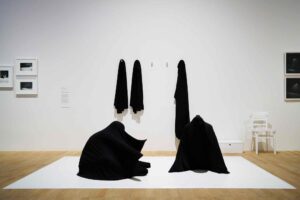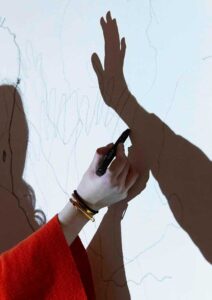Yoko Ono Retrospective Reveals a 1960s Conceptual-Art Visionary
from London

Tate Modern, London, 2024. Photo
© Tate (Reece Straw)
‘Take another little piece of my heart’, sang Janis Joplin in 1968, covering a song originally recorded in the previous year by Aretha Franklin’s sister Erma Franklin. ‘You know you’ve got it, ‘cause it makes you feel good’. Joplin made codependence seem normal. She never got to see American women have the right to their own lines of credit (1974), much less the right to register same-sex partnerships like her own as marriages. This song’s combination of helplessness and rage probably helped to make Joplin the voice of a generation of American women.
Then, there was Yoko Ono, subject of the solo show Yoko Ono: Music of the Mind at London’s Tate Modern through December. Born in 1933, she also made music, like she made everything, as a form of protest art. Unlike Joplin, she never sang at Woodstock. She never accepted her many and obvious traumas as her total identity, but her art confronted them again and again. I use the word ‘art’ the way Oscar Wilde and other Victorian Aesthetes did – genre and medium don’t matter, only the intent to produce something that didn’t exist previously and that might inject a troubled world with beauty or hope. Slightly before Joplin’s messy musical scream, there was Ono, sitting onstage while (mostly) white-collar men (entirely) in actual white-collar shirts eagerly snipped away bits of her neat black suit, camisole, and bra, without making eye contact with her. That performance-art action, ‘Cut Piece’, sticks with me more than anything else I saw in the Tate Modern’s illuminating Ono retrospective. In the 1960s film of ‘Cut Piece’, the camera zeroes in on Ono’s face while the cutters hone in on her body. She stares straight ahead. She does not smile. She aims to please nobody. Her text says that ‘Cut Piece’ is about ‘giving’ to the cutters, the audience, but there’s no emotional ‘give’, and an absolute refusal to engage. What she does here is amazing: she captures sociopathic white-collar male (and a few dolled-up women’s) behavior on film, in stark black and white, and she refuses to enthuse about it in any way. They can have another little piece of her textile shell, but no pieces of her heart.
The show overall reveals Ono as a subversive thinker who pioneered a lot of important concepts in conceptual art, and whose search for an artistic community that understood her, in Japan, London, and New York, was only partly successful. As a child, she was evacuated to the country during the Second World War. That she was aware of the American nuclear bombing of Hiroshima and Nagasaki, and witnessed the aftermath, underpins her entire oeuvre. Her Peace Trees installation (1996) revives a ritual that Ono witnessed in postwar Japan. Three olive trees in planters, look like oversized bonsai. The audience is asked to decorate them with cream paper tags on which we must write our hopes and wishes. Of course, there are many wishes for peace: solipsistic wishes for inner, personal peace, sincere and empty platitudes, specific topical demands (mostly for a ceasefire in Palestine, but there’s an election coming up soon, so ‘Tories Out’ also made an appearance), and some tags quoting John Lennon’s ‘Imagine’, of course. That the responses are predictable doesn’t make the aggregation of collective thinking less powerful. The trees fill up and the tags are taken down routinely. They will be posted to Ono’s foundation in Iceland. Someday they’ll make an interesting archive.
Ono’s family moved to America, and, after a year as the first female Philosophy student at a Japanese university, she transferred to Sarah Lawrence College, then as now a mecca of artistic activity. She dropped out. That’s too bad: her work’s one weakness is dependence on platitudes and easy answers to big problems, which is exactly what college-level critical-thinking complicates. I’m sure that at the time she had to contend with unimaginable degrees of sexism, xenophobia, and what Edward Said had yet to name Orientalism, but college still might have armed her with tools to effectively subvert all the institutions that her art protests. After college, she joined various art collectives. Clearly, she was looking for an intellectual community. Her early instruction art pieces used the medium of the typewriter to give scripts to audience members, telling the public how to make her art, and how to make it their own. One of the best of these is ‘Bag Piece’, in which people are told to envelop themselves in gigantic black satin (I think?) bags and stand, one or two at a time, on a white platform in a bright spotlight in front of the white gallery wall. They become living sculptures. As reconstructed by the public at the Tate, Bag Piece is fascinating. I can see how it anticipates performance art by the equally conceptual but far more popular Swiss mime troupe Mummenschantz.
Less interesting was ‘A Hole’ (2009), in which the audience is instructed to view the world through a plate glass window’s bullet hole. In America anyway, a lot of people are already doing that, very unintentionally. Putting the shot-through glass in a gallery and making people look through the hole likely for the first time simply reveals just how upper-class the conceptual art audience Ono envisioned was and is.
Sometimes the audience subverts the project. At one point Ono asked the audience to affix notes to a wall praising their mothers. I did this easily. Lots of other visitors to the Tate had great things to say about their mothers. Some mourned their mothers. Others were deeply ambivalent, using the exercise to call out toxic relationships. (There was a lot of anger at stepmothers in the notes on the wall.) Also probably unintended were topical revisions of older pieces. In ‘Boat Piece’ (2019), to protest refugees dying at sea trying to reach safe harbors, Ono placed a small boat painted white in the center of a whitewashed gallery and asked people to write words of protest on the boat, walls, and floor. In April 2024, the words that stick out of the blue haze are mostly concerned with Palestine: ‘Free Palestine’, ‘From the River to the Sea’, or just ‘Palestine’. The masses (or the part of the masses that visits the Tate Modern) determine the art’s meaning and message.

Photo © Tate (Lucy Green)
So do other external powers. One is the Tate Modern’s technology. I’d have liked to see the film of ‘Cut Piece’ and other projects on film, as Ono intended. That all her 1960s films appeared to be shown as digital projections made them look distractingly granular, but that might have been the only efficient way to revive them. Another is the political establishment. Ono and Lennon sent boxes of acorns to many world leaders, asking them to plant oak trees for peace. Some wrote back saying they’d planted them, or with other forms of acknowledgement. Tellingly, all of the official replies signed by heads of state on display at the Tate Modern address the couple as Mr. John Lennon (named first) and either Mrs. Lennon, or ‘Yoko Ono Lennon’, or something like that, always second–even though she was the conceptual artist of longer standing and the project was probably her idea. Some of the leaders also pushed back against Lennon and Ono’s instruction, sometimes in terms that in retrospect are entirely predictable. Israeli Prime Minister Golda Meir ‘greatly appreciated the gesture, the underlying symbolism of which she would indeed like to see take root within a realistic framework’, her secretary declared. Then as now, you can’t make people ‘give peace a chance’ by ordering them around.
I should say something about how the Tate Modern handles the long shadow of John Lennon. He’s included when it’s absolutely necessary to mention him: when Ono meets him, their marriage, the work they did together. His assassination in 1980 is covered in one sentence in the catalog. If it was mentioned explicitly in the gallery’s wall text, I didn’t notice. I can understand why the Tate Modern made this choice. Her art predates their relationship, she seems to have determined the themes and methods of most of their collaborative work, and she has kept making art for four decades after his death. She’s not reducible to his muse nor his widow. The Tate Modern showed zero criticism of the ineffective, hypocritical, and damaging aspects of his intervention in her art. Does it matter that the sloganeer of ‘Give Peace a Chance’ battered his first wife? Or that in ‘Bed Piece’ he mentions everything that Western peace activists were doing ‘for Biafra’–when we now know that the Biafra War was actually escalated by the infusion of Western Aid and that ‘Christian charity’ propaganda exploited Nigerian children and was the very definition of white savior virtue-signaling? It might not be politic to critique Ono’s dead lover-collaborator’s ideas in her solo show, during her lifetime. (She’s in her nineties, now.) I accept the inevitability of that.
Even with critique of Lennon muted, ‘Bed Piece’, the action and film of the action in which newlyweds Ono and Lennon invited journalists to their hotel-room honeymoon to protest the Vietnam War, has not aged well. It reeks of entitlement, Lennon does most of the recorded talking (and what he says is utterly vapid). Ono’s few interjections are the most sensible statements in the piece. It was exactly the kind of Hippie Yeah Man Peace Out Love Spectacle that people without college degrees in the endless tiny towns of the American Rust Belt probably imagined when they resisted ‘hippies’ attempts to question the war and aspects of American culture that had entrenched the war. At the same time, it’s worth noting that there’s nothing exhibitionist about Ono’s performance of ‘Bed Piece’. She almost sits in judgement of American society; but in a kind of judgment that is far more patient and observational than Lennon’s nagging outbursts. Changing one’s entire worldview and then political policy meaningfully is not ‘easy if you try’. It’s not easy at all. That, however, is why it needs doing, as Ono clearly was and is mindful.
Yoko Ono: Music of the Mind is at the Tate Modern until September 2024.

